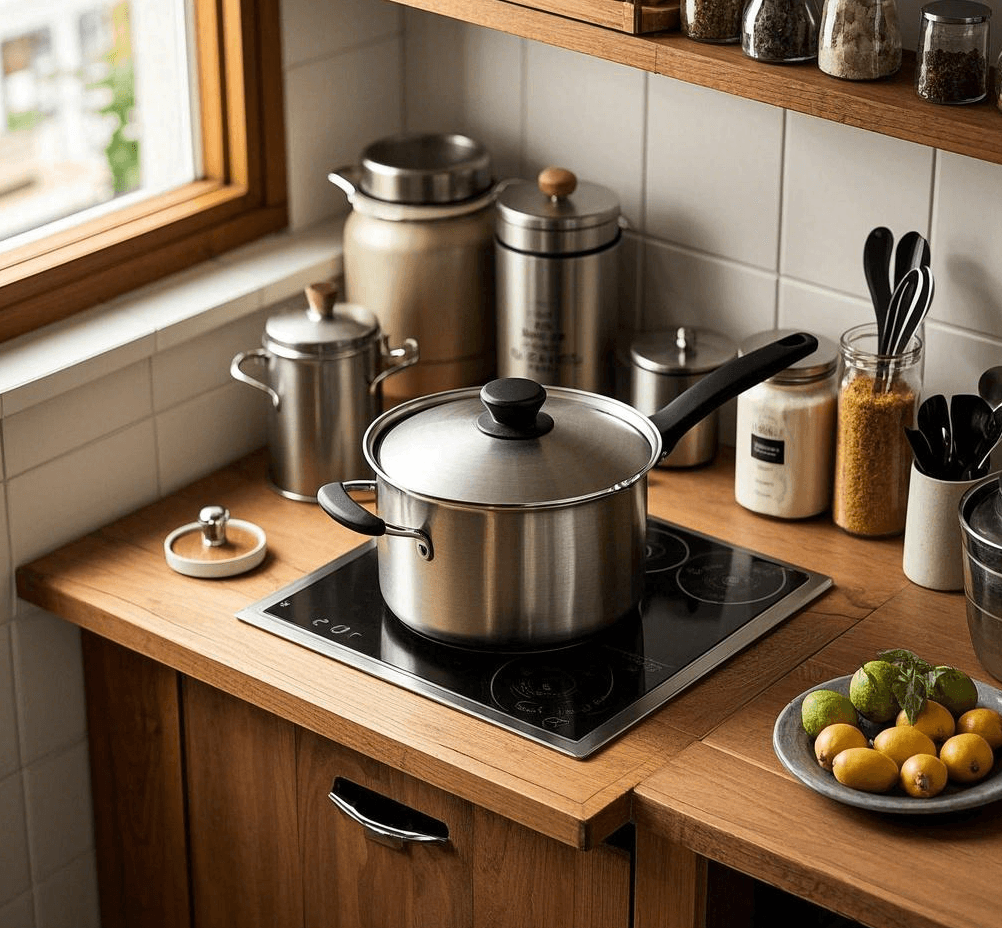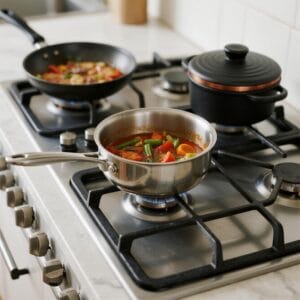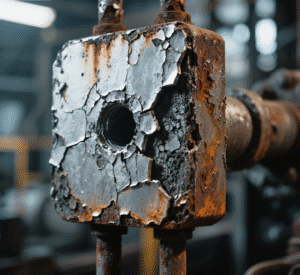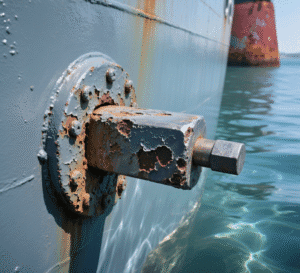Choosing new pots and pans can be confusing with so many materials available. You might worry about spending money on cookware that doesn’t last or isn’t safe for your health.
Stainless steel, especially tri-ply, is often the best all-around material for its durability, even heating, and safety 1 2. Cast iron is great for heat retention, while ceramic and titanium are top choices for health-conscious cooks 3 4 5.
Finding the right material really depends on what you value most – performance, health, ease of use, or longevity 2. I’ve used a tri-ply stainless steel pot myself for over 12 years. Honestly, it’s been fantastic—it heats up fast, cooks evenly, is easy to clean, and incredibly durable. Since getting into sales, I’ve learned more about the technology behind it, and I really appreciate why it works so well. It’s become a popular choice, especially in Western homes and for families looking for quality that lasts. Let’s dig into the different materials to help you choose.
What is the healthiest material for pots and pans?
Worried about chemicals leaching into your food from your cookware? It’s a valid concern, and choosing the right material can give you peace of mind. Let’s look at the safest options.
The healthiest materials are generally considered to be stainless steel, cast iron, ceramic (high-quality, PFOA/PFAS-free), and titanium because they are non-reactive and don’t leach harmful substances 3 4 5.
Health is a top priority for many home cooks. The key is choosing materials that won’t react with your food, especially acidic ingredients, and don’t rely on potentially harmful coatings.
Why Material Choice Impacts Health
Some cookware materials can react with foods (like acidic tomatoes) or release chemicals, especially when scratched or overheated. Non-stick coatings, particularly older types or lower-quality ones, have faced scrutiny over chemicals like PFOA and PFAS. Choosing inherently stable and non-reactive materials is the safest bet 5 2.
Top Choices for Healthy Cooking
- Stainless Steel: A workhorse in the kitchen, high-quality stainless steel (like 18/10 grade or in tri-ply construction) is durable, non-reactive, and doesn’t have coatings to worry about 3 4. It’s great for all types of cooking.
- Cast Iron: Both bare and enameled cast iron are considered safe. Bare cast iron, when seasoned, develops a natural non-stick surface and can even add a small amount of dietary iron to your food 3 4. Enameled cast iron has a glass-like coating that is inert.
- Ceramic: This usually refers to ceramic-coated cookware or solid ceramic. Quality ceramic coatings (like those from GreenPan or Caraway) are non-toxic and provide non-stick properties without PFOA/PFAS 3 4. Solid ceramic is inert but less common and can be brittle.
- Titanium: Known for being extremely strong, lightweight, and completely non-reactive and non-toxic 5. It’s often used in high-end cookware or camping gear, sometimes as a coating or blended with other materials. It’s also hypoallergenic.
| Material | Reactivity | Coating Concerns | Leaching Risk | Notes |
|---|---|---|---|---|
| Stainless Steel | Low | None | Very Low | Quality matters (e.g., 18/10) |
| Cast Iron (Bare) | Low | None (needs seasoning) | Low (Iron) | Adds dietary iron |
| Cast Iron (Enam) | Low | None (enamel is inert) | Very Low | Avoid chipping the enamel |
| Ceramic (Coated) | Low | Check PFOA/PFAS-free | Low | Coating durability varies 3 4 |
| Titanium | Very Low | None | Very Low | Often expensive, very inert 5 |
What type of material is best for cookware?
Trying to decide which single material is the absolute "best"? It’s tough because different materials excel at different things. What works for one cook might not suit another.
For overall balance, stainless steel (especially multi-ply like tri-ply) is often considered the best due to its blend of durability, even heating, versatility, and ease of maintenance 1 2.
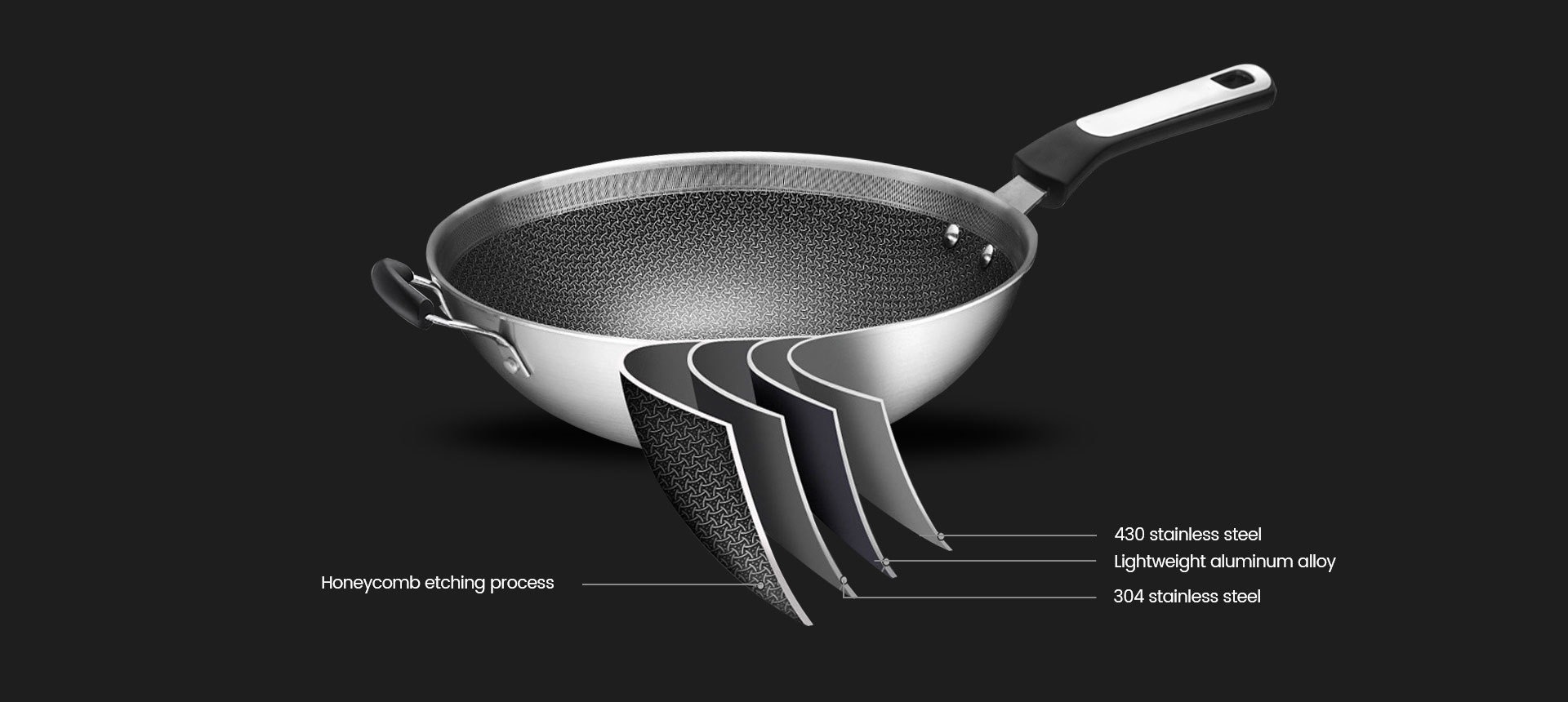
The "best" really depends on how you cook and what you prioritize 2. Do you need precise heat control, maximum durability, or non-stick convenience? Let’s compare the main contenders based on key performance factors.
Key Factors Defining "Best"
When evaluating cookware materials, we generally look at 2:
- Heat Conduction: How quickly and evenly does it heat up?
- Heat Retention: How well does it hold heat?
- Durability: How resistant is it to warping, scratching, and damage?
- Reactivity: Does it react with certain foods?
- Maintenance: How easy is it to clean and care for?
- Weight: Is it easy to handle?
- Price: What’s the initial cost and long-term value?
Comparing the Top Materials
- Stainless Steel (esp. Tri-Ply): Excellent balance. The aluminum core in tri-ply provides great heat conduction, while the stainless steel layers ensure durability, non-reactivity, and easy cleanup 5 1. It handles high heat well and doesn’t need seasoning 1 2. This matches my own long experience – it just works reliably.
- Cast Iron: Unbeatable heat retention, making it ideal for searing and slow cooking 4 2. Extremely durable but heavy and requires seasoning (if bare) to prevent rust 4. Heats slowly and less evenly than tri-ply 1.
- Copper: The best heat conductor, offering rapid and precise temperature control 2. It’s beautiful but expensive, heavy, reactive (usually lined), and requires polishing 2.
- Aluminum: Lightweight, heats very quickly, and is affordable. However, it can warp, scratch easily, and react with acidic foods unless it’s anodized or part of a clad construction (like tri-ply) 1.
- Non-Stick (Ceramic/PTFE): Offers excellent food release and easy cleanup, great for low-fat cooking 3 2. Downsides include lower heat tolerance and coating degradation over time, requiring more careful handling 4.
| Feature | Tri-Ply Stainless | Cast Iron | Copper (Lined) | Aluminum (Anodized) | Non-Stick (Ceramic) |
|---|---|---|---|---|---|
| Heat Speed | Fast & Even 1 | Slow | Very Fast 2 | Very Fast | Fast |
| Heat Retention | Good | Excellent 4 | Good | Poor | Poor-Moderate |
| Durability | Excellent 1 | Excellent | Good | Fair-Good 1 | Fair-Good 4 |
| Maintenance | Easy 4 | Moderate (Season) | High 2 | Easy | Easy (Gentle Care) |
| Weight | Medium 4 | Heavy 4 | Heavy | Light | Light-Medium |
| Price | Med-High | Low-Med | Very High | Low-Med | Low-High |
Is stainless steel or ceramic better for pans?
Choosing between stainless steel and ceramic pans is common. They offer different cooking experiences, so which one suits you better? Understanding their core differences helps.
Stainless steel (especially tri-ply) is better for durability, versatility across cooking methods (like searing), and longevity 1. Ceramic is better for easy non-stick cooking and cleanup, particularly with delicate foods 3 4.
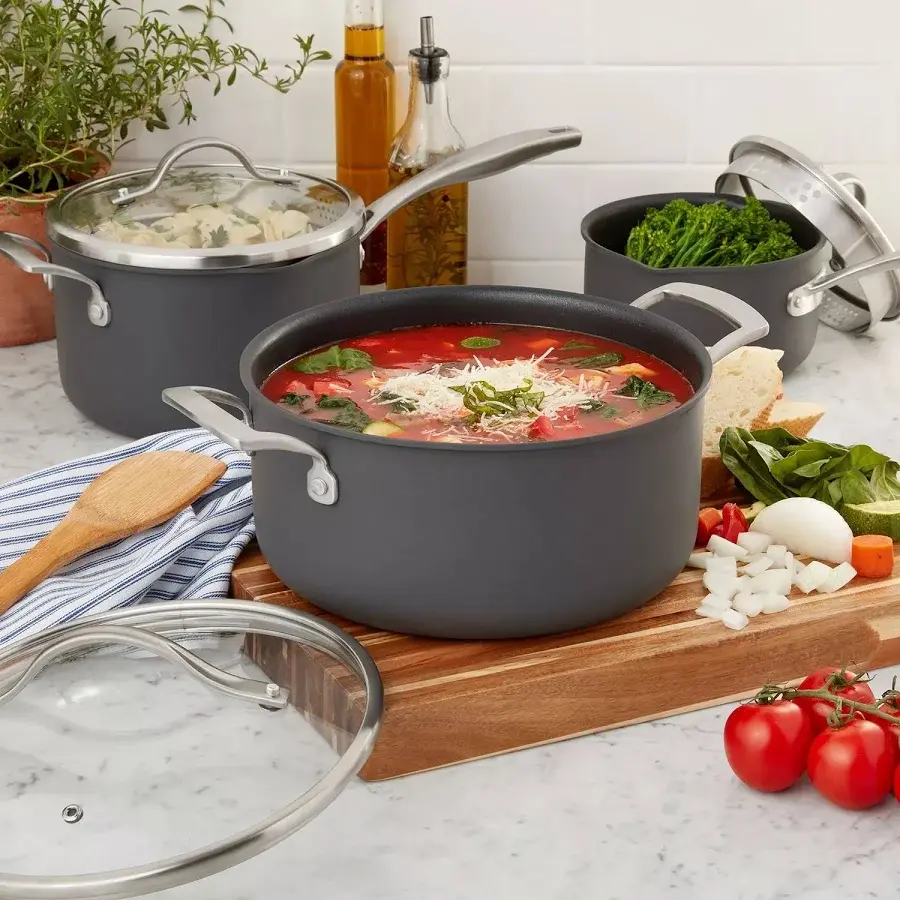
Both can be great additions to your kitchen, but they serve slightly different purposes. Let’s break down the comparison.
Performance and Cooking Style
- Heating: High-quality stainless steel, particularly tri-ply, heats very evenly due to its core material (usually aluminum) 1 2. This prevents hotspots and is great for consistent results. Ceramic pans can heat quickly, but heat distribution might be less even, and they don’t retain heat as well.
- Searing & Browning: Stainless steel excels here. It can handle high heat and allows food to develop a nice crust (fond), which is great for making pan sauces. Ceramic non-stick surfaces are generally not ideal for high-heat searing, as high temperatures can damage the coating 4.
- Food Release: Ceramic non-stick coatings offer superior food release, making them ideal for things like eggs, pancakes, and delicate fish 3. Stainless steel requires proper heating and oil use to prevent sticking, though it’s not truly non-stick.
Durability and Maintenance
- Longevity: Stainless steel pans, especially quality ones, can last a lifetime 1. They are resistant to scratches, warping, and staining. Ceramic coatings, even high-quality ones, will inevitably wear down over time and lose their non-stick properties, requiring eventual replacement 4.
- Care: Stainless steel is generally low maintenance and can often go in the dishwasher (check manufacturer instructions). It can handle metal utensils (though wood/silicone is still recommended to preserve the finish). Ceramic requires more care – avoid metal utensils, high heat, abrasive scouring pads, and often handwashing is recommended to prolong the coating life 3 4.
Health Aspects
Both are considered healthy choices if you select quality products. Stainless steel is inherently non-reactive 3 4 5. For ceramic, ensure it’s from a reputable brand and certified free of PFOA, PFAS, lead, and cadmium 3 4.
| Feature | Stainless Steel (Tri-Ply) | Ceramic (Coated) |
|---|---|---|
| Best For | Searing, sautéing, general use | Eggs, delicate foods, low-fat cook |
| Heat Evenness | Excellent 1 | Good |
| Durability | Very High 1 | Moderate (coating wears out) 4 |
| Non-Stick | No (requires technique) | Yes (initially excellent) 3 |
| Maintenance | Easy 4 | Moderate (gentle care needed) |
| Versatility | High | Moderate (heat limits) |
What is the best type of pots and pans to use?
Feeling overwhelmed and just want to know what to actually buy and use every day? You need reliable cookware that handles most tasks well without fuss. Let’s get practical.
For most home cooks, high-quality stainless steel cookware, particularly tri-ply or multi-clad construction, is the best type for everyday use due to its versatility, durability, safety, and performance 5 1 2.

While specialized pans have their place, having a core set of reliable, versatile cookware makes daily cooking much easier and more enjoyable.
Why Stainless Steel (Tri-Ply) Wins for Daily Use
From my experience both cooking and in sales, tri-ply stainless steel hits the sweet spot for most people:
- Versatility: It works beautifully for boiling, simmering, sautéing, searing, and even oven use (check handle/lid temperature limits) 1 2. It’s compatible with all cooktops, including induction 1.
- Durability: This stuff is built to last. It resists warping, scratching, and staining, making it a great long-term investment 1. My own pot lasting 12+ years is testament to this.
- Performance: The layered construction ensures fast, even heating, leading to better cooking results and fewer frustrations with burnt or unevenly cooked food 1 2.
- Safety & Ease of Care: It’s non-reactive, so safe for all foods, and doesn’t require special seasoning 5 1 2. Cleaning is generally straightforward.
Supplementing Your Core Set
While stainless steel is the best all-rounder, you might want a couple of other pieces for specific tasks:
- A Good Non-Stick Skillet (Quality Ceramic): Perfect for eggs, pancakes, and delicate fish where easy release is paramount 3 4. Treat it gently and expect to replace it eventually.
- A Cast Iron Skillet: If you love searing steaks, baking cornbread, or want something that can go from stovetop to campfire, cast iron is fantastic 4 2. It requires a bit more care (seasoning) but lasts forever.
Focus on Quality over Quantity
Rather than buying a huge, cheap set, invest in a few high-quality core pieces of stainless steel cookware (like a saucepan, a stockpot, and a large skillet). You can always add specialized pieces later as needed. Good quality tri-ply material, like the circles we supply, forms the foundation of excellent, long-lasting cookware 2.
Conclusion
Stainless steel, especially tri-ply, offers the best overall balance of performance, durability, and safety for most cooks. Consider cast iron, ceramic, or titanium for specific health or cooking needs.
Highlights tri-ply’s construction (stainless-aluminum-stainless), durability, resistance to warping, suitability for high heat, even heating, and lack of need for seasoning compared to cast iron or aluminum. Source: https://triplycircletitanium.com/which-cookware-material-is-better-for-high-heat-cooking/
andhttps://triplycircletitanium.com/how-does-the-lifespan-of-tri-ply-cookware-compare-to-aluminum-cookware/ ↩ ↩ ↩ ↩ ↩ ↩ ↩ ↩ ↩ ↩ ↩ ↩ ↩ ↩ ↩ ↩ ↩ ↩ ↩ ↩Discusses factors for choosing cookware (heat conductivity, reactivity, maintenance, durability, weight, health). Mentions stainless steel’s versatility, copper’s heat control, cast iron’s heat retention, and non-stick’s convenience. Highlights tri-ply’s benefits (heat distribution, durability, cooktop compatibility). Source: https://triplycircletitanium.com/choosing-the-best-cookware-material-which-option-fits-your-cooking-style/` and ‘https://triplycircletitanium.com/which-cookware-material-is-better-for-high-heat-cooking/‘ ↩ ↩ ↩ ↩ ↩ ↩ ↩ ↩ ↩ ↩ ↩ ↩ ↩ ↩ ↩ ↩ ↩ ↩ ↩ ↩
Mentions ceramic-coated pans (like GreenPan, Caraway) and stainless steel as great non-toxic/healthy choices. Source: https://triplycircletitanium.com/what-is-the-healthiest-cookware-to-use/` ↩ ↩ ↩ ↩ ↩ ↩ ↩ ↩ ↩ ↩ ↩ ↩ ↩ ↩
Lists stainless steel, ceramic coating, and cast iron as top choices for health. Mentions brands like All-Clad (stainless), GreenPan/Caraway (ceramic), Our Place/Staub (cast iron). Source: https://triplycircletitanium.com/what-is-the-healthiest-cookware-to-use/` ↩ ↩ ↩ ↩ ↩ ↩ ↩ ↩ ↩ ↩ ↩ ↩ ↩ ↩ ↩ ↩ ↩ ↩ ↩ ↩ ↩ ↩ ↩ ↩
States titanium, stainless steel, and ceramic are generally healthiest due to non-reactive/safe properties. Considers tri-ply ideal for health due to heat distribution/non-reactivity. Ranks titanium highest for health (light, durable, non-toxic, hypoallergenic). Source:
https://triplycircletitanium.com/which-cookware-material-is-healthiest-for-your-lifestyle/↩ ↩ ↩ ↩ ↩ ↩ ↩ ↩ ↩

